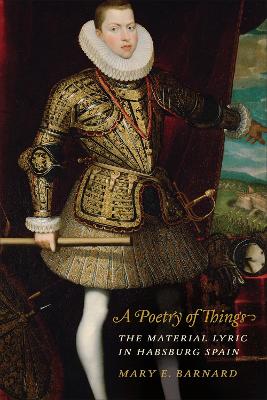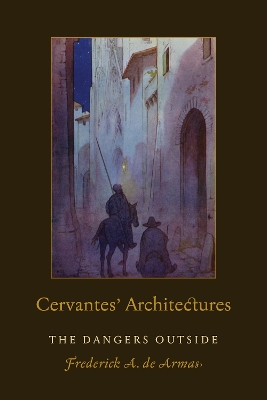Toronto Iberic
1 primary work • 4 total works
Book 5
Objects of Culture in the Literature of Imperial Spain
by Mary Barnard and Frederick A. de Armas
Published 14 March 2013
Collecting and displaying finely crafted objects was a mark of character among the royals and aristocrats in Early Modern Spain: it ranked with extravagant hospitality as a sign of nobility and with virtue as a token of princely power. Objects of Culture in the Literature of Imperial Spain explores how the writers of the period shared the same impulse to collect, arrange, and display objects, though in imagined settings, as literary artefacts. These essays examine a variety of cultural objects described or alluded to in books from the Golden Age of Spanish literature, including clothing, paintings, tapestries, playing cards, monuments, materials of war, and even enchanted bronze heads. The contributors emphasize how literature preserved and transformed objects to endow them with new meaning for aesthetic, social, religious, and political purposes -- whether to perpetuate certain habits of thought and belief, or to challenge accepted social and moral norms.
Garcilaso de la Vega and the Material Culture of Renaissance Europe
by Mary Barnard
Published 14 November 2014
Garcilaso de la Vega and the Material Culture of Renaissance Europe examines the role of cultural objects in the lyric poetry of Garcilaso de la Vega, the premier poet of sixteenth-century Spain. As a pioneer of the "new poetry" of Renaissance Europe, aligned with the court, empire, and modernity, Garcilaso was fully attuned to the collection and circulation of luxury artefacts and other worldly goods. In his poems, a variety of objects, including tapestries, paintings, statues, urns, mirrors, and relics participate in lyric acts of discovery and self-revelation, reveal memory as contingent and unstable, expose knowledge of the self as deceptive, and show how history intersects with the ideology of empire. Mary E. Barnard's study argues persuasively that the material culture of early sixteenth-century Europe embedded within Garcilaso's poems offers a key to understanding the interplay between objects and texts that make those works such vibrant inventions.
A Poetry of Things examines the works of four poets whose use of visual and material culture contributed to the remarkable artistic and literary production during the reign of Philip III (1598-1621). Francisco de Quevedo, Luis de Gongora, Juan de Arguijo, and Luisa de Carvajal y Mendoza cast cultural objects - ranging from books and tombstones to urban ruins, sculptures, and portraits - as participants in lively interactions with their readers and viewers across time and space.
Mary E. Barnard argues that in their dialogic performance, these objects serve as sites of inquiry for exploring contemporary political, social, and religious issues, such as the preservation of humanist learning in an age of print, the collapse of empires and the rebirth of the city, and the visual culture of the Counter-Reformation. Her inspired readings explain how the performance of cultural objects, whether they remain in situ or are displayed in a library, museum, or convent, is the most compelling.
Mary E. Barnard argues that in their dialogic performance, these objects serve as sites of inquiry for exploring contemporary political, social, and religious issues, such as the preservation of humanist learning in an age of print, the collapse of empires and the rebirth of the city, and the visual culture of the Counter-Reformation. Her inspired readings explain how the performance of cultural objects, whether they remain in situ or are displayed in a library, museum, or convent, is the most compelling.
Cervantes’ Architectures is the first book dedicated to architecture in Cervantes’ prose fiction. At a time when a pandemic is sweeping the world, this book reflects on the danger outside by concentrating on the role of enclosed structures as places where humans may feel safe, or as sites of beauty and harmony that provide solace. At the same time, a number of the architectures in Cervantes trigger dread and claustrophobia as they display a kind of shapelessness and a haunting aura that blends with the narrative.
This volume invites readers to discover hundreds of edifices that Cervantes built with the pen. Their variety is astounding. The narrators and characters in these novels tell of castles, fortifications, inns, mills, prisons, palaces, towers, and villas which appear in their routes or in their conversations, and which welcome them, amaze them, or entrap them. Cervantes may describe actual buildings such as the Pantheon in Rome, or he may imagine structures that metamorphose before our eyes, as we come to view one architecture within another, and within another, creating an abyss of space. They deeply affect the characters as they feel enclosed, liberated, or suspended or as they look upon such structures with dread, relief, or admiration.
Cervantes' Architectures sheds light on how places and spaces are perceived through words and how impossible structures find support, paradoxically, in the literary architecture of the work.
This volume invites readers to discover hundreds of edifices that Cervantes built with the pen. Their variety is astounding. The narrators and characters in these novels tell of castles, fortifications, inns, mills, prisons, palaces, towers, and villas which appear in their routes or in their conversations, and which welcome them, amaze them, or entrap them. Cervantes may describe actual buildings such as the Pantheon in Rome, or he may imagine structures that metamorphose before our eyes, as we come to view one architecture within another, and within another, creating an abyss of space. They deeply affect the characters as they feel enclosed, liberated, or suspended or as they look upon such structures with dread, relief, or admiration.
Cervantes' Architectures sheds light on how places and spaces are perceived through words and how impossible structures find support, paradoxically, in the literary architecture of the work.



